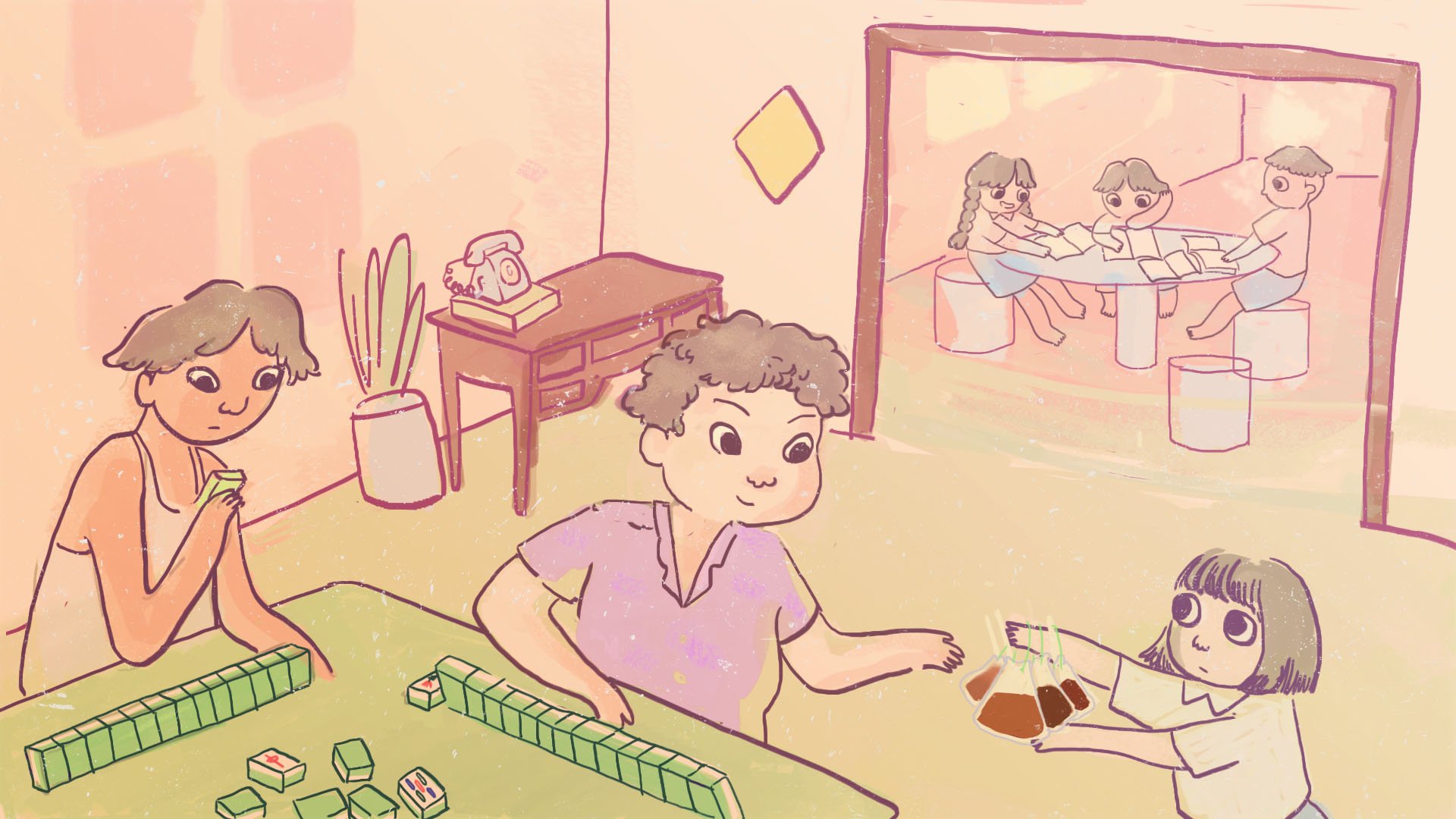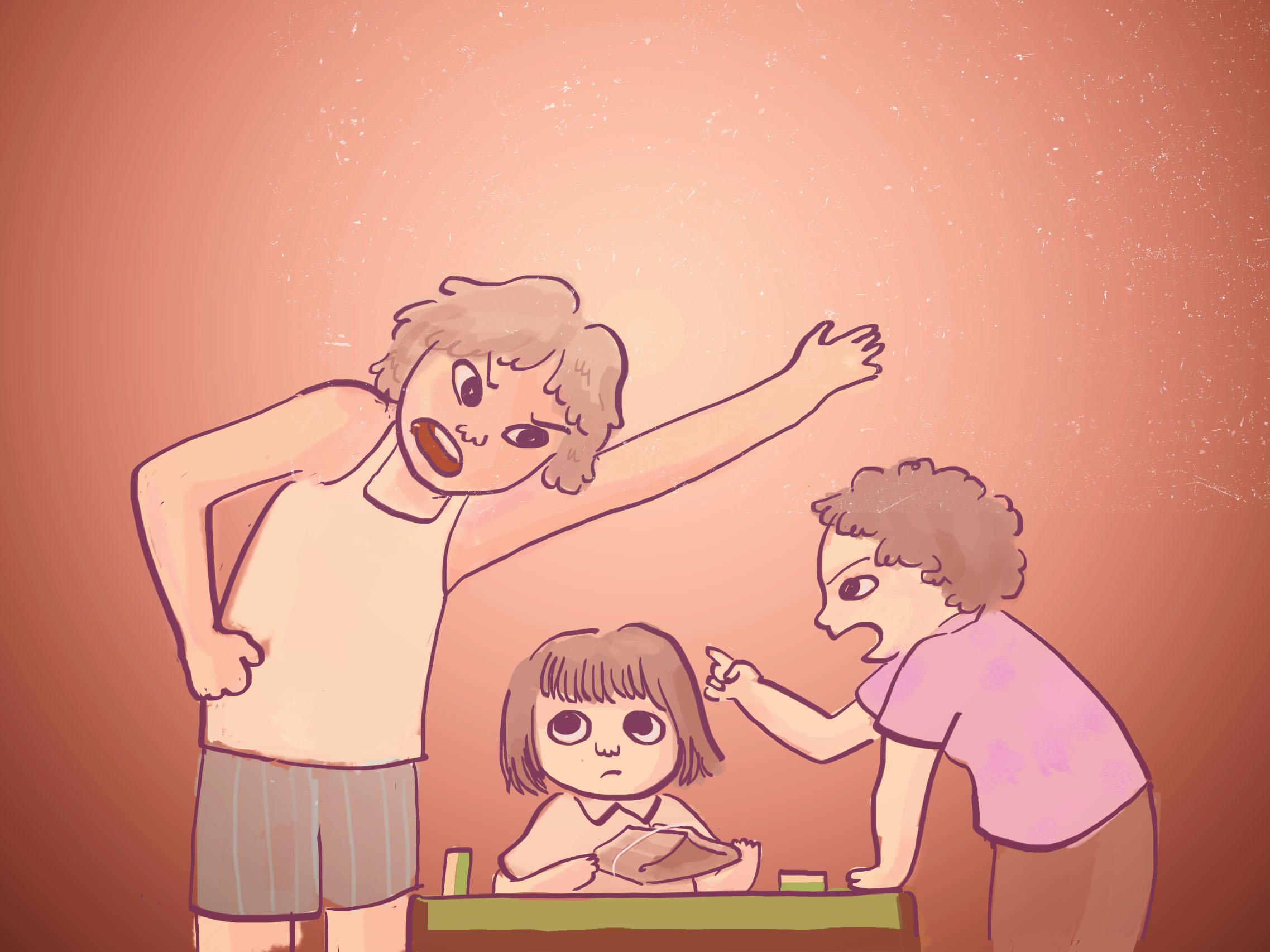The tiles and tribulations of 1970s community mahjong
Illustrated by Hazel Koh
This is the first of two articles examining traditional games as a window into personal and family histories. Our marketing executive Hazel interviewed her mother Yee Lee to learn about mahjong and how it shaped her childhood.
On a humid afternoon in early-1970s Singapore, four adults sit in a shophouse playing a tabletop game. Amidst animated gossiping and boisterous conversation, they turn thick plastic tiles over in their hands, careful not to let their expressions slip as they plan their next move. There’s money on the table, a few dollars or so per round—nothing excessive, but enough to raise the stakes.
Down the hall, a group of children, schoolmates from the primary school across the street, sit on stone seats, chattering gaily as they do their homework on a circular stone table next to the bathroom. They can hear the adults shouting at the end of a particularly heated round, followed by the distinct cacophonous shuffling of mahjong tiles marking the start of a new game.
One of the children, Yee Lee, is called to the front of the shophouse. She’s tasked to give her grandmother, the master of the house, a massage – sitting table-bound for eight hours a day is “not good for circulation”, she’s told. She’d been going on errands to buy food and drinks for the mahjong players since she was about four years old, sometimes even helping them purchase cigarettes.
“That time got no regulation that young kid cannot buy cigarettes,” shares Yee Lee, now 55, and the girl in question.
Mahjong, a traditional tile-based game developed in 19th century China, was a regular feature in Yee Lee’s childhood home. She remembers her grandmother playing Monday through Saturday, nine to five, with a rotation of adults from around the neighbourhood – mostly people in their 40s who weren’t actively working. Other than its game mechanics, which give players multiple ways to win through a combination of luck and strategy, Yee Lee believes that it’s the social nature of the game that kept them hooked for over 20 years between the 1950s and late 1970s.
Mahjong typically requires four players, bar some three-person variations played in parts of China, Japan, South Korea and Southeast Asia. Faced with three other people for sessions that would often last eight hours, the players would gossip and talk about their families, “exposing [their] private lives to the mahjong table”, as Yee Lee says. Because she was always assisting her grandma in what she terms “Grab service and massage service”, likening her fetching food for the adults to modern app-based food delivery services, she was often nearby, catching snippets of adult conversation. She was even privy to some dark secrets.
Illustrated by Hazel Koh
“Sometimes they just slip their tongue and tell you things they’re not supposed to,” she shares. Yee Lee found out about neighbours committing adultery, or moonlighting as karaoke hostesses, a controversial job in those circles.
The game also brought out certain sides of people – adults who usually appeared calm revealed their “true character” by becoming excitable or irritable on the mahjong table. “They cannot lose. Once they lose, they lose [their] temper as well.” Games would end with “unpleasant” quarrelling and “strong words” exchanged, but Yee Lee assures that it didn’t impact her badly. Besides, the players would soon make up and return to the house for another round.
“I think it contributed to my knowledge about [interpersonal] relationships that maybe other children are not exposed to,” she shares. “I [became] more mature than… people of the same age group.”
Regular gaming groups today may conjure to mind people roleplaying with miniatures and 20-sided dice in Dungeons & Dragons, or board games with elaborate themes and art direction. Yee Lee’s story shows how regular game groups have been a way for people to spend time together and socialise for generations.
Although chance-based games are shunned by certain circles of seasoned board gamers, the combination of luck and strategy needed for mahjong is what keeps the game exciting. “Even [if] you are a very skilled mahjong player, you can still lose a game.”
Players lean into this element of luck as part of the gaming experience, appealing to the gods of chance using feng shui and lucky objects or clothing. (Some players even change their underwear to ward off the bad luck from a loss.)
Coupling a familiar social experience with the thrill of (usually light) gambling, mahjong has achieved what many contemporary tabletop games can only dream of – decades of relevance and replayability.
Mahjong continues to be popular with many circles in Singapore, and has even seen a rise in interest among Gen Zers, with many young players picking up this classic tabletop game while they were stuck at home due to pandemic restrictions. Youths interviewed in the article echoed Yee Lee’s sentiments, citing social reasons, such as forging friendships and learning about the character of fellow players, for their continued interest in mahjong.
“This is a game [that] not only involve[s] the skill of the game,” states Yee Lee, “[but] your analytical power, as well as your socialising power.”
Look out for our second article on traditional games next month. Our marketing assistant Natasha will be sharing about carrom and the comfort it offers her father at work. To be the first to receive the article, sign up for our Level Up newsletter.


